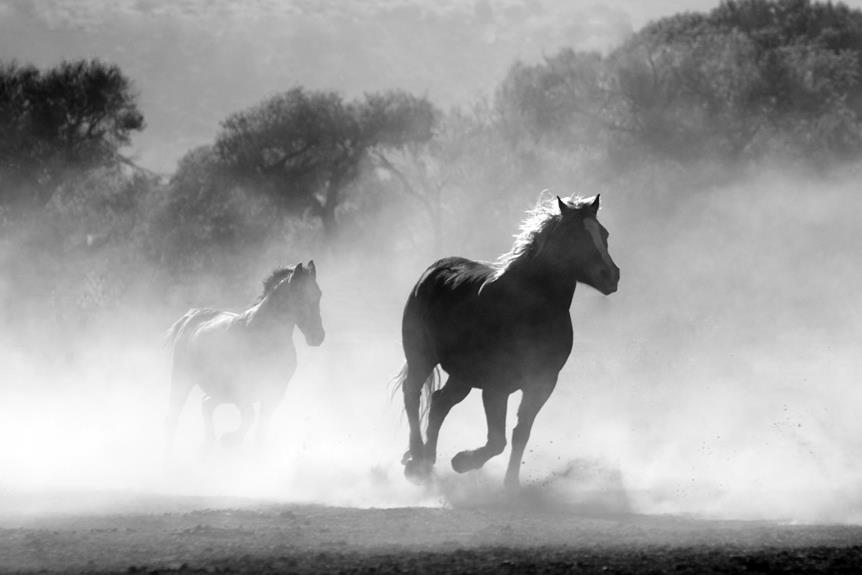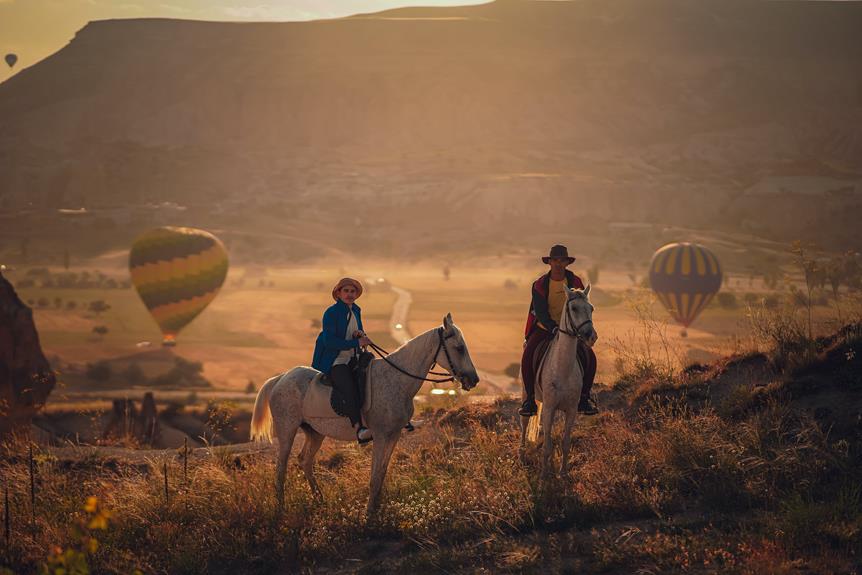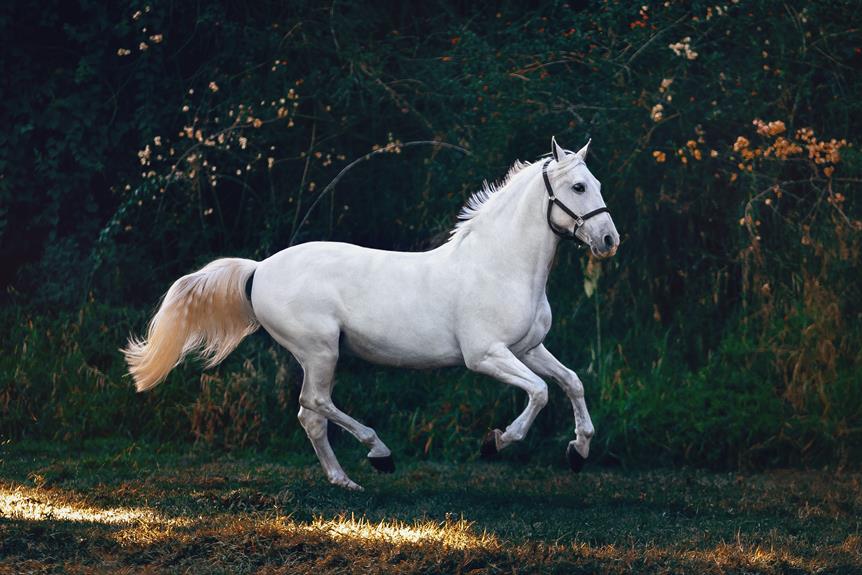So, you're wondering how much a pony costs? Well, let's start with an example. Imagine you're strolling through a local horse auction, and you come across a beautiful Welsh pony. Its chestnut coat glistens under the sunlight, and its gentle eyes meet yours. Instantly, you're captivated.
But before you can make this pony your own, you need to know how much it will cost. That's where things get interesting. The price of a pony can vary greatly, and there are several factors at play. From breed and age to training and size, each element contributes to the overall cost.
But don't worry, I'll take you through all the details, and by the end, you'll have a clearer picture of just how much it takes to bring a pony into your life.
Key Takeaways
- Pony prices vary based on factors such as breed, temperament, pedigree, age, and training.
- Different pony breeds have different price ranges, with Shetland ponies being the cheapest and Connemara ponies being the most expensive.
- Owning and maintaining a pony can be costly, with expenses including housing, vet care, feeding, and additional accessories.
- Training and education costs are also important, with fees for general training, specialized training, and owner education. Ongoing education and training are necessary for the pony's well-being and performance.
Factors Affecting Pony Prices
The price of a pony is influenced by various factors, including its breed, temperament, pedigree, age, level of training, and housing options. When considering the cost of a pony, it's important to take into account these factors that can greatly affect the overall price.
Firstly, the breed of the pony plays a significant role in determining its cost. Different pony breeds vary in size, temperament, and price. Some pony breeds are more sought after and therefore more expensive than others. For example, Welsh ponies and Arabian ponies are known to be popular choices and tend to command higher prices.
Secondly, the temperament of the pony also affects its price. Gentle and well-mannered ponies are in high demand and are therefore more expensive. On the other hand, ponies with a difficult temperament may be less expensive.
Additionally, the pedigree of the pony can impact its price. Ponies with strong bloodlines and impressive pedigrees are often more sought after by buyers, leading to higher prices.
Furthermore, factors such as age and level of training also play a role in determining the cost of a pony. Generally, younger ponies and those with extensive training tend to be priced higher than older or less trained ponies.
Lastly, the housing options for the pony can significantly contribute to its overall cost. The costs of boarding and housing can vary depending on the type of accommodation, ranging from pasture boarding to full board with luxury accommodations. Each option comes with different costs, which should be considered when calculating the total expenses of owning a pony.
Different Breeds and Their Costs
When considering the costs associated with owning a pony, it's important to understand the varying prices associated with different breeds. The prices per pony can vary greatly depending on the breed and other factors.
Some popular pony breeds include Shetland ponies, Welsh ponies, and Connemara ponies. Shetland ponies are known for their small size and friendly nature. They can range in price from $200 to $2,000, depending on factors such as age and training.
Welsh ponies are versatile and often used for riding and showing. They can range in price from $1,000 to $5,000.
Connemara ponies, known for their athleticism and endurance, can range in price from $3,000 to $10,000. It's important to note that these prices are general estimates and can vary in different regions and markets.
Additionally, older ponies may be available at lower prices, but may also require more care and maintenance. When looking to buy a pony, it's important to research the specific breed and market in order to have a better idea of what to expect to pay.
Expenses for Pony Care and Maintenance
To properly care for and maintain a pony, it's important to be aware of the various expenses involved. Owning a live animal will incur several costs that need to be considered before making the decision to adopt or purchase a pony. Here are some key expenses to keep in mind:
- Cost of owning: The average cost of a pony can range from $200 for smaller breeds to well into the thousands for larger ponies. The purchase price alone can be a significant expense.
- Housing: Housing costs for ponies can vary depending on the type of boarding and services provided. Monthly costs can range from $200 to $1,100.
- Vet care: Regular vet visits are necessary to ensure the health and well-being of your pony. The average cost of a vet visit can be around $250.
- Feeding: Ponies eat hay, grain, minerals, and concentrates, which can add up to an annual cost of around $1,200.
- Additional expenses: It's important to budget for pony accessories, unexpected costs, and reduced cost opportunities. Proper financial planning and budgeting are essential for responsible pony ownership.
Training and Education Costs
Now let's dive into the costs associated with training and educating your pony. Training and education costs for ponies can vary widely based on the level of training needed and the expertise of the trainer. Specialized training, such as dressage or jumping, can increase the cost of pony training. Discipline-specific trainers charge higher fees for their expertise. In addition to pony training, you may need to invest in your own education as well. Clinics or lessons to improve your riding skills can range from individual lessons to more expensive clinics. Advanced training programs like pony camps or intensive training sessions can provide a more immersive educational experience for both you and your pony. These programs typically cost between $500 to $1,000 per week. It's important to factor in ongoing education and training costs into your overall expenses for pony ownership to ensure your pony receives the necessary skills and care for their well-being and performance.
| Training and Education Costs | |
|---|---|
| Level of Training Needed | $1,000 – $2,000 per year |
| Specialized Training | Higher Fees |
| Owner Education | $40 – Several hundred dollars |
| Advanced Training Programs | $500 – $1,000 per week |
Additional Costs to Consider
Pony ownership comes with various additional costs that should be considered when budgeting for your pony's care. These costs can add up quickly and require a lot of money to properly care for your pony. Here are some important expenses to keep in mind:
- Pony housing and boarding: The cost of housing and boarding can range from $200 to $1,100 per month, depending on the type of boarding and services provided. It's important to find a safe and suitable place for your pony to live.
- Pony food and supplements: Feeding your pony can cost around $1,390 per year. This includes expenses for hay, grain, minerals, and concentrates. Adding grain and other supplements to their diet can help keep them healthy and strong.
- Veterinary expenses: Regular check-ups and core vaccinations for your pony can amount to approximately $345 per year. This doesn't include additional costs for emergency visits or care for aging or sickly ponies. Regular dentist visits are also important for your pony's dental health.
- First aid supplies: It's important to have a well-stocked first aid kit for your pony. This can include items like bandages, disinfectant, and wound ointment. These supplies can be vital in case of injuries or emergencies.
- Unexpected expenses: Ponies are prone to certain health issues, such as colic, which may require immediate veterinary attention. It's important to have some extra funds set aside for unexpected medical expenses.
Owning a pony can bring joy and fulfillment, but it's essential to be prepared for the financial responsibilities that come with it. By understanding these additional costs and budgeting accordingly, you can ensure that your pony receives the care it needs.
Frequently Asked Questions
How Much Is a Miniature Pony?
A miniature pony can range in price depending on factors such as breed, age, and training. It's important to consider the cost of ownership, health care, and grooming needs when budgeting for a miniature pony.
How Much Is a Pony for Kids?
When considering a pony for kids, there are many factors to consider. Look for pony breeds suitable for children, consider the costs of training and care, and find the right size for your child.
What Is a Pony in Gambling?
A pony in gambling refers to various betting strategies involving multiple winning combinations. It has a rich history and famous gamblers. To choose the right pony, understand the odds, use tips for success, and avoid common mistakes. Manage your bankroll wisely.
Is 20 Old for a Pony?
At 20 years old, a pony is considered a senior. Common health issues in older ponies include arthritis and dental problems. Best care practices include regular vet check-ups, adjusting exercise routines, and providing a balanced diet.
Conclusion
So, if you're considering buying a pony, it's important to understand the various factors that can affect their price. Factors like breed, age, and training can greatly influence the cost of a pony.
Additionally, it's crucial to remember that owning a pony involves ongoing expenses for their care, such as food, boarding, grooming, and veterinary care.
By considering all these factors, you can make an informed decision and ensure that owning a pony fits within your budget.



0 Comments